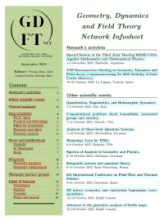Relative Geodesics in the Special Euclidean Group
We propose a notion of distance between two parametrized planar curves, called their discrepancy, and defined intuitively as the minimal amount of deformation needed to deform the source curve into the target curve. A precise definition of discrepancy is given as follows. A curve of transformations in the special Euclidean group SE(2) is said to be admissible if it maps the source curve to the target curve under the point-wise action of SE(2) on the plane. After endowing the group SE(2) with a left-invariant metric, we define a relative geodesic in SE(2) to be a critical point of the energy functional associated to the metric, over all admissible curves. The discrepancy is then defined as the value of the energy of the minimizing relative geodesic. In the first part of the paper, we derive a scalar ODE which is a necessary condition for a curve in SE(2) to be a relative geodesic, and we discuss some of the properties of the discrepancy. In the second part of the paper, we consider discrete curves, and by means of a variational principle, we derive a system of discrete equations for the relative geodesics. We finish with several examples.

